There’s no denying a red flowering tree’s staggering visual appeal. Red is a show-stopping color, and there are lots of gorgeous red flowering trees in Florida due to its warmer temperatures. Many red flowering trees prefer tropical environments, so Florida’s USDA hardiness zones 8 to 11 suit them quite literally down to the ground. Here are 10 gorgeous red flowering trees in Florida.
1. Red Bottlebrush
Bottlebrush best suits growing zones 9A to 11. It’s an evergreen that’s native to Australia with a single trunk and rounded canopy. It can reach 30 feet tall and 25 feet wide in Florida.
Its dense, bright green foliage is linear, and in spring, its branches are festooned with vibrant, bright red blooms that resemble bottle brushes. As well as springtime flowers, red bottle brush trees often bloom at random times during the year.
This red flowering tree requires well-drained soil and a sunny spot in the yard. It’s drought tolerant once established, but like all new trees, it needs lots of water when it’s first planted. Pruning isn’t required, but any dead or odd-looking branches can be cut out in winter.
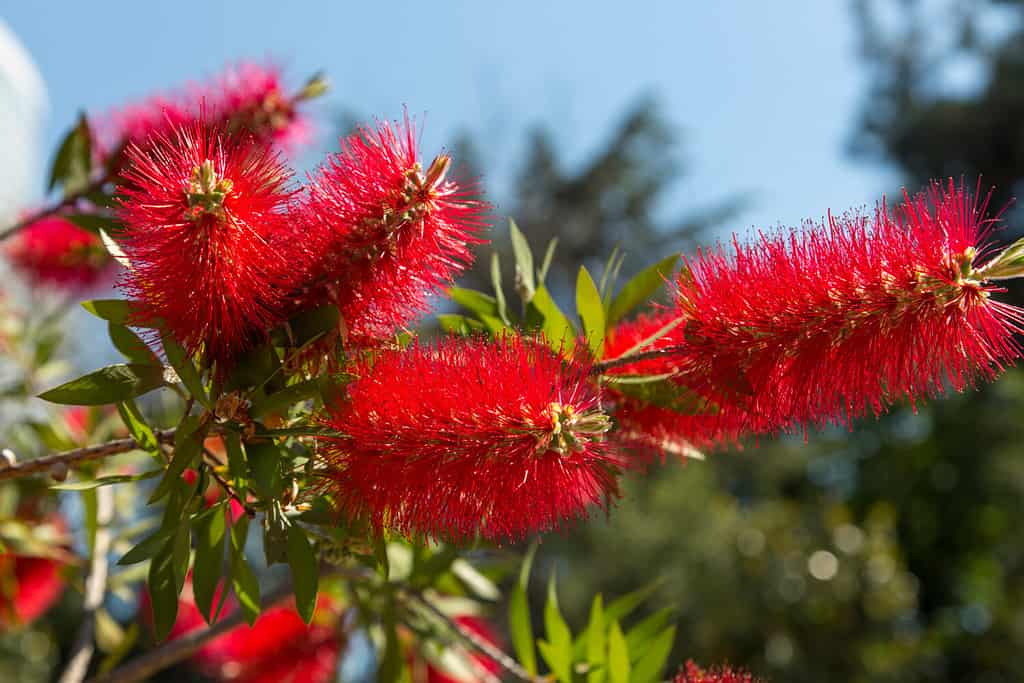
Red flowering bottle brush trees are Australian natives.
©lucky eyes/Shutterstock.com
2. Peregrina Tree
Star-shaped red flowers cover peregrina trees all year round. This red flowering tree or shrub loves South Florida’s tropical climate and produces such bright scarlet inch-wide blooms it’s impossible to miss.
A native of Cuba, evergreen peregrina trees reach 15 feet tall with a symmetrical open crown of pale brown branches and glossy bronze foliage that matures to rich deep green.
Hummingbirds love peregrina trees, and it’s drought tolerant once established. Plant this beauty in free-draining soil in a sunny spot, and it’ll produce flowers as soon as its roots feel settled.
Prune it in early spring, if necessary, before new glossy bronze growth appears.
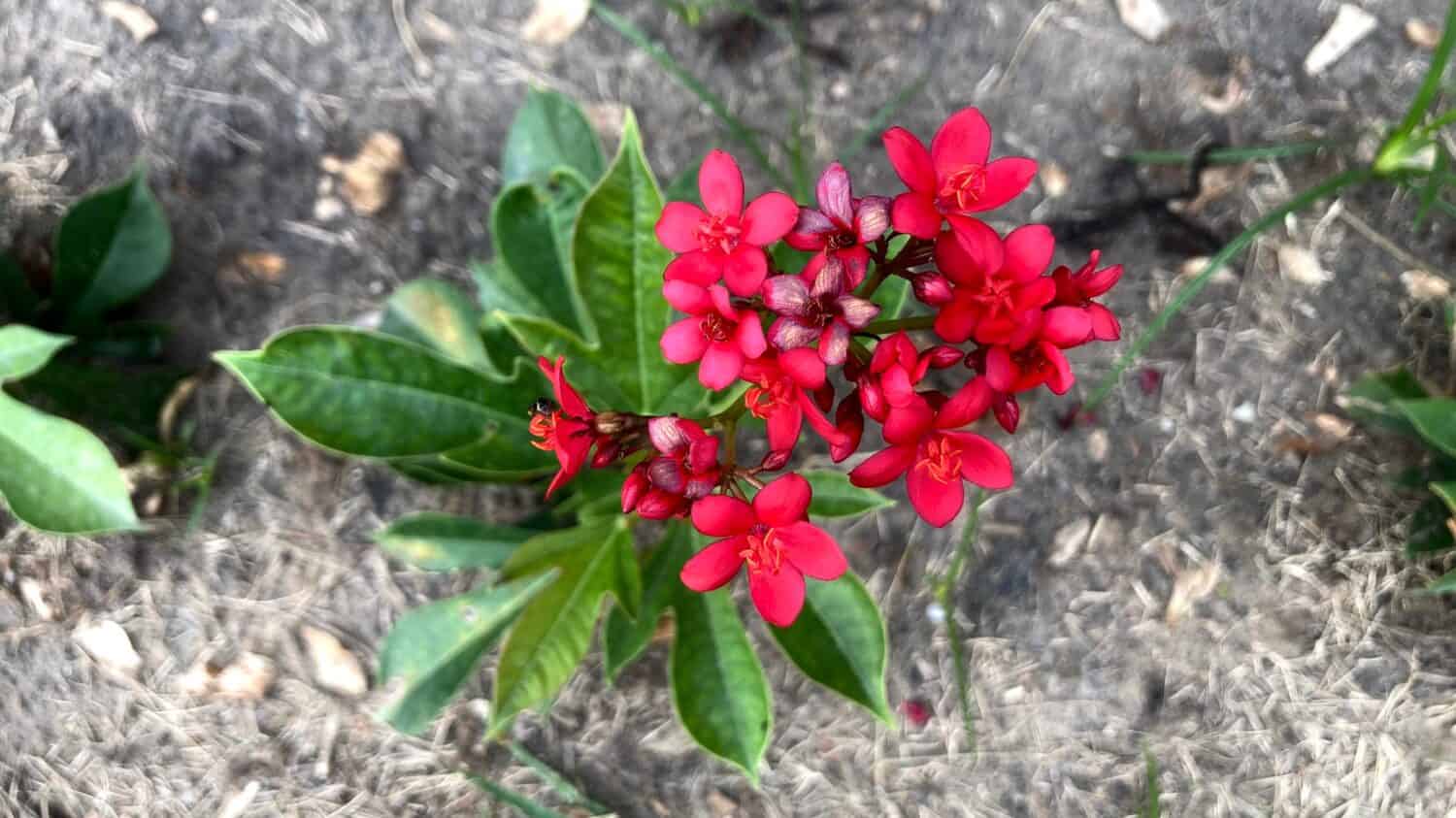
Peregrina trees suit compact gardens and sunny mixed-flower borders.
©BUNDHIT PATTA/Shutterstock.com
3. Red Hummingbird Tree
The 10-foot-tall red hummingbird tree, Sesbania Grandiflora, is a beautiful, ornamental red-flowering tree in Florida. It loves warmth and moisture, and it grows so quickly that landscape designers often choose it for shade.
The red hummingbird tree is a pea family member, and it’s named for pretty red flowers resembling flying hummingbirds. Not only are the flowers attractive, they’re tasty, too! In southeastern Asian cuisine, cooks use its red flowers and burgundy seed pods as curry vegetables.
A sunny spot and plenty of water ensure a red hummingbird tree thrives in Florida. They’re so suited to the climate that the University of Florida believes they may become invasive in the future.
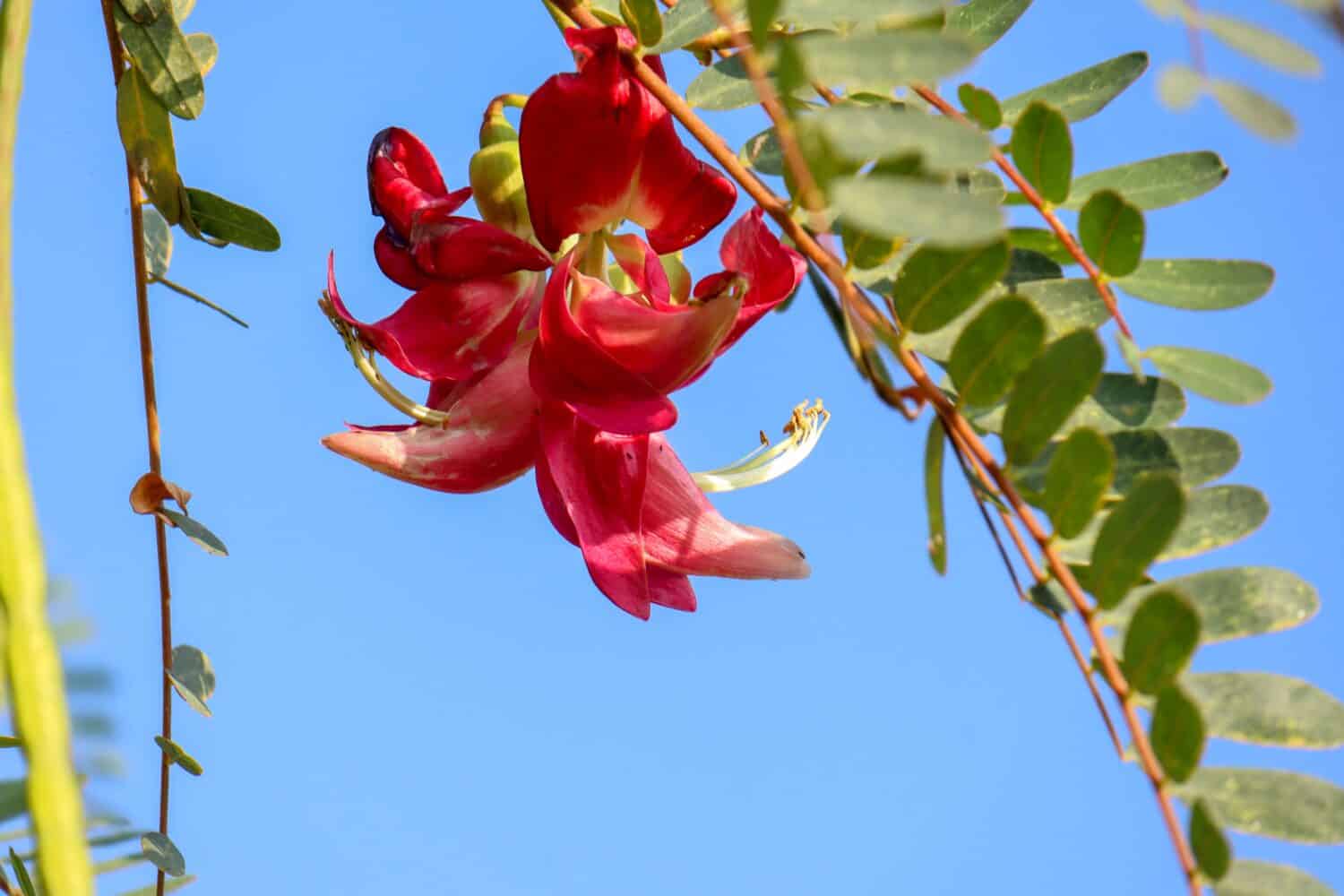
The red hummingbird tree gets its name from hummingbird-shaped flowers.
©Zula Albab/Shutterstock.com
4. Red Buckeye
Nontropical red buckeye is one of the few native red flowering trees in North America.
This deciduous tree has shiny dark green leaves that droop downwards, and its vivid red flowers blossom in erect clusters in spring. Expect its foliage to drop in early fall and emerge before other deciduous trees the following year.
Because red flowering buckeye is native, it requires less cossetting than tropical trees. It thrives in Florida’s cooler zone 8 in the north but struggles in the hottest places such as West Palm Beach or Miami.
Plant red buckeye in free-draining soil with at least four hours of direct sun a day and water well until it’s established. Red buckeye reaches 10-20 feet tall and spreads across the same distance, so it needs room to stretch its red flowering branches.
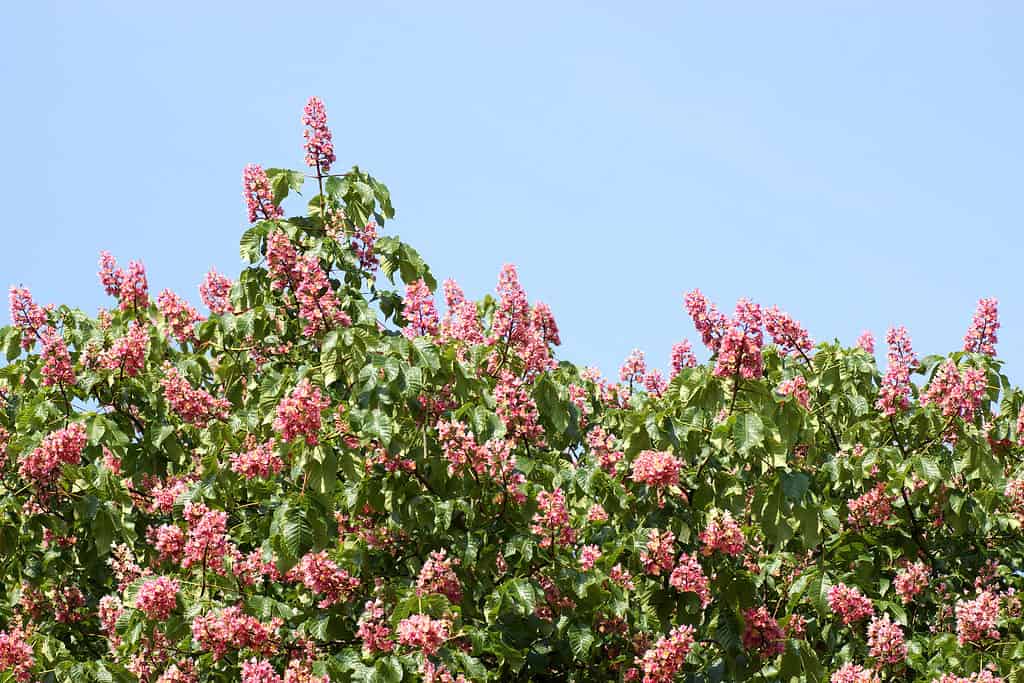
Florida native red buckeye tree produces beautiful red flowers in spring.
©Bildagentur Zoonar GmbH/Shutterstock.com
5. Pomegranate Tree
Another great red flowering tree in north Florida is the pomegranate tree. It’s a deciduous tree in the north that often remains evergreen in the warmer south. Its vibrant red flowers emerge in spring and summer. Their tube-shaped form attracts hummingbirds and large bees.
In fall, red fruits develop and remain on the tree for months across the winter, so a pomegranate tree is a good bet if you’re looking for red shades across the year.
12-20-foot-tall, easy-to-grow pomegranate trees prefer partial shade and tolerate most soil types that free-drain. It doesn’t like waterlogged roots or all-day blazing sun in the south. Choose a spot shaded from the midday sun in zones 10 and above.
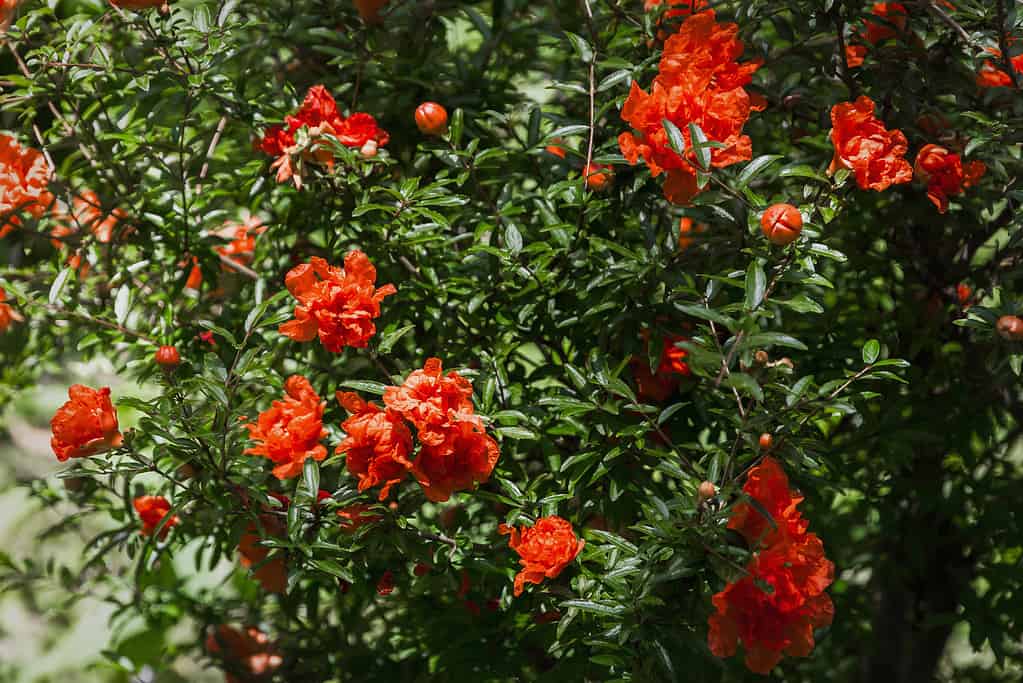
Red pomegranate trees prefer warmth and partial shade, so they thrive in north Florida.
©Vitaliy Shkadinov/iStock via Getty Images
6. Red Flowering Gum Tree
Australian native red flowering gum tree blossoms in late summer. This beauty displays extravagant red, pink, and orange flower clusters at the end of each mature branch.
It’s a fast-growing tree with aromatic foliage, much like its fellow Australian eucalyptus. Landscapers use red gum trees to freshen air in high humidity zones such as 10 and 11.
Red flowering gum is a large tree that won’t suit compact yards. It reaches 30-40 feet tall, and its crown spreads over 25 feet. Sandy, acidic soil on the coast is preferred, but most very well-drained, sunny spots suit it, too.

Australian native red gum tree grows to 30 feet tall.
©alybaba/Shutterstock.com
7. African Tulip Tree
Huge clusters of orange-red flowers herald a tulip tree. This one is hard to miss even when its fuzzy, warm brown buds emerge in late spring. Rapidly growing African tulip trees flower in late winter and early spring, so it’s only suitable for frost-free zones 10B and above.
Choose sandy soil with free drainage and plenty of sunshine. It’s salt tolerant and copes with moderate drought. In suitable growing conditions, red flowering African tulip tree reaches 50-60 feet tall and 50 feet wide. It’s the largest red flowering tree on this list.
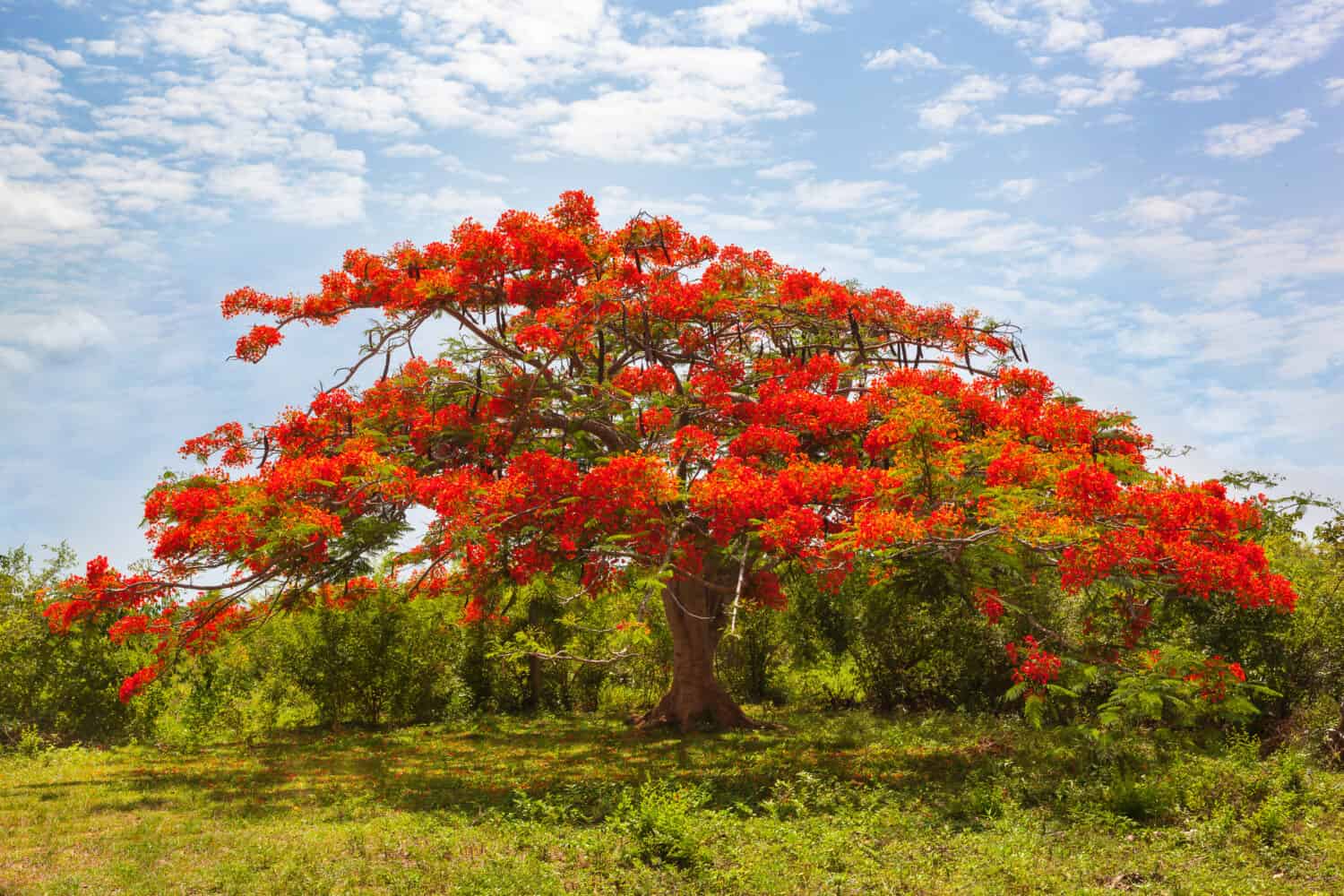
African tulip tree produces huge orange-red flowers in zones 10B and above.
©Eskymaks/Shutterstock.com
8. Royal Poinciana
When folks say, “What’s the red flowering tree in Florida?” It’s usually a royal poinciana.
This Madagascan native is known for its dramatic and vivid display of orchid-like red flowers in May and June. Clusters hang from its 40-70-foot-wide umbrella-shaped crown, creating a vibrant display and attracting hummingbirds and all types of Floridian pollinators.
In zones 10B and above 30-40 feet tall, royal poinciana is an excellent landscaping tree for shade, but it won’t flower until it’s around five years old. Unfortunately, frost will kill this temperature-sensitive tree. The lowest zone it could survive is 9B, with its mild, occasional frosts.
Plant royal poinciana in full sun, or it won’t bloom. Well-drained soil is another must, but it provides plenty of water for the first few years as it beds into the soil and develops a strong root system.
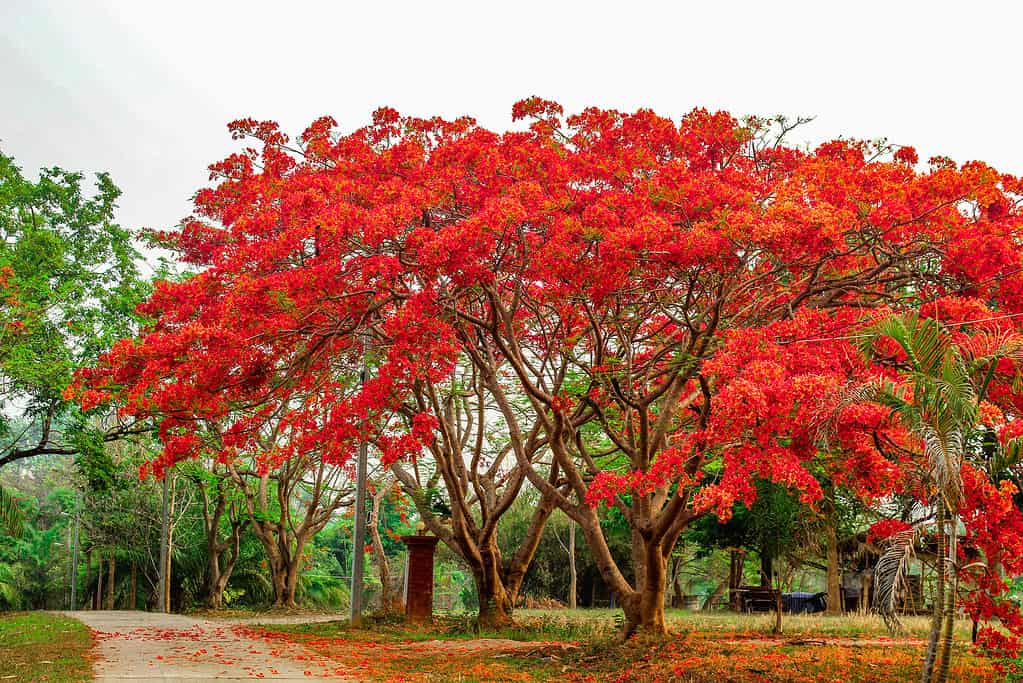
Royal Poinciana is a commonly spotted red flowering tree in Florida.
©Randall W Simpson/Shutterstock.com
9. Red Crape Myrtle
Chinese native crape (also spelled crepe) myrtle’s distinctive crinkled red flowers bloom all summer long in Florida. It’s a popular tree with backyard gardeners and a reliable small landscaping tree for compact spaces. In very small spaces, a dwarf crape myrtle tree is a more manageable size.
Lagerstroemia indica is deciduous, and mature trees have exfoliating bark that’s especially handsome in summer when bare branches are on display. It’ll thrive across all of Florida’s growing zones in well-drained soil and full sun.
Are you worried it’ll need extensive and time-consuming pruning each year? Don’t be. It’s a disproven theory. In the past, horticulturists thought crape myrtle bloomed on new wood, so cutting back to barely anything produced more flowers. Sadly, this is not the case because crape myrtle blooms on old and new wood. Cutting away all its branches just weakens the tree, making it prone to disease and infection. This technique is called “crape murder” today.

Red crape myrtle trees suit small yards and bloom throughout the summer.
©Satoshi Mizushima/Shutterstock.com
10. Red Oleander
Breath-taking oleander will grow in all of Florida’s hardiness zones. Depending on the variety, this evergreen tree has pink, lilac, purple, orange, yellow, or red blooms, but all bloom for most of the year. Hummingbirds are fond of its colorful, funnel-shaped flowers.
Shrubby oleander trees spread out to form a round crown that’s salt tolerant, and they only reach six to 15 feet tall, much shorter than many of Florida’s red flowering trees. Its evergreen leaves grow in whorls of three to four lanceolate fingers that provide interest in the short periods when it’s not flowering.
This small red flowering tree for Florida is suitable for compact yards and mixed flower borders in full sun. Free-draining soil is a must, as is plenty of water until it’s established.

Hummingbirds love red oleander’s funnel-shaped flowers.
©ChiccoDodiFC/Shutterstock.com
The photo featured at the top of this post is © Randall W Simpson/Shutterstock.com
Thank you for reading! Have some feedback for us? Contact the AZ Animals editorial team.






